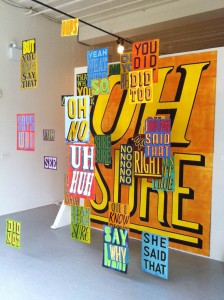 And Then She’s Like
And Then She’s Like
And He Goes
Curated by Chris Campe
August 9 – September 15, 2012
A+D Gallery, 619 S. Wabash Ave, Chicago
Gallery Hours:
Tuesday – Saturday 11 am – 5 pm
Thursday 11 am – 8 pm
Closing Reception: September 6, 2012, 5–8pm
ColumbiaCrawl, a campus-wide evening of visual and performing arts
6pm, Gallery Talk with the artists followed by a performance of
The Wilhelm Scream by Jeff Kolar
Participating Artists:
Anne Vagt
Jana Sotzko & Elen Flügge
Deb Sokolow
Mark Addison Smith
Tony Lewis
Jeff Kolar
Chris Campe
Mark Booth
And Then She’s Like/ And He Goes combines text-based visual art with language-based sound art. The visual pieces in the exhibition emphasize the audible qualities that hand rendered letterforms add to text, and the audio pieces play with the visual potential of sound.
Someone is telling us that she said something and he answered—what we don’t know. What we do know: there are at least three people involved here: she, he, and the person telling us about their conversation. And actually, we are involved, too. It is up to us, the audience, to speculate what she said and he replied, or what she inquired and how he responded, or what she threw at him and what he retorted. Even though the content of the dialog is left out its colloquial language evokes distinct voices in our head and entices us to imagine what is going on.
The exhibition And Then She’s Like, And He Goes combines text-based visual art with language-based sound art to highlight the works’ multi-sensory appeal as a mode of storytelling. Seeing and reading text in an artwork involves hearing, even if only inside the viewers head, and listening to spoken words and sound involuntarily brings images to the mind‘s eye, even when the language is not straightforwardly descriptive. The artists examine these audible qualities of image-text and the visual potential of language and sound. Intertwining documentation and fabulation they give us audio/visual bits and pieces and use non-linear narrative to draw us into their stories. Rather than over the course of the traditional beginning, middle, and end the narrative comes alive in the overlap between word, image and sound. Although there is no way of knowing for sure what she said and he replied, the works in the show invite us to be involved in the story.
More information?
Here’s a link to the show’s catalog, with an essay by John Corbett:
http://www.colum.edu/ADGallery/Exhibits/2012_and_then_shes/andthen_issue.pdf